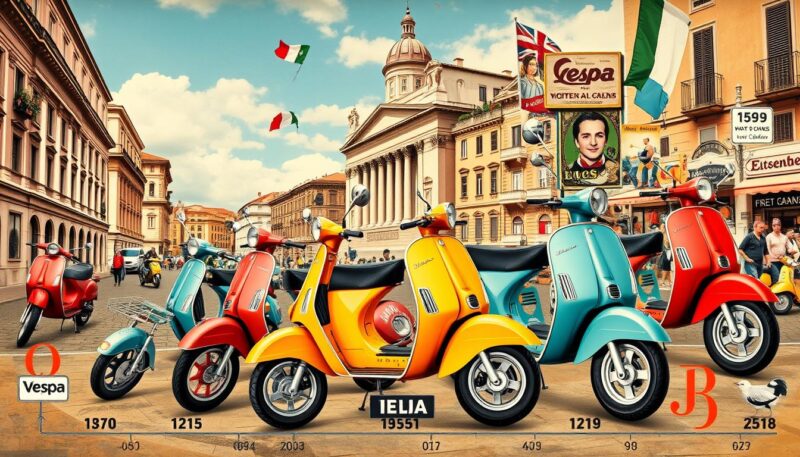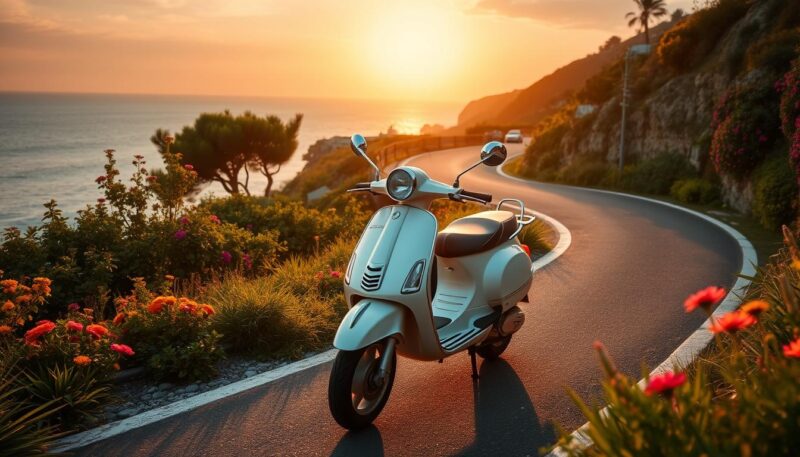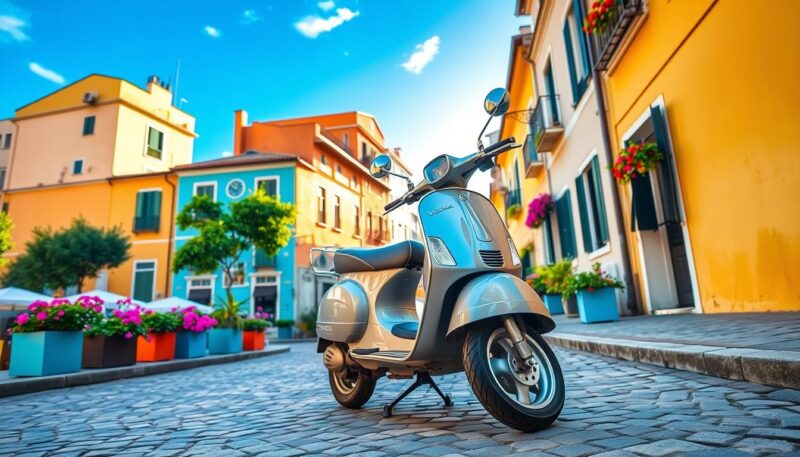If you’ve ever asked yourself, “what is a Vespa?” you’re not alone. This iconic Vespa scooter is more than just a mode of transportation; it represents a blend of style, engineering, and cultural heritage that has captivated riders around the globe since its inception. Manufactured by Piaggio since 1946, the Vespa has become synonymous with freedom, adventure, and the open road.
In 2024, Piaggio will celebrate a remarkable 140 years of operation, introducing a limited edition ‘Vespa 140th of Piaggio’ with only 140 units available for dedicated fans. This scooter has transcended its practical origins to embody a lifestyle embraced by millions, making Vespa ownership a rite of passage for many enthusiasts.
From its humble beginnings—selling just around 2,500 units in 1947—and achieving heights of over ten million sold by the late 1980s, the Vespa’s journey through history is as rich as its design. With an array of models catering to various needs, from the 50cc ideal for urban commuting to the 150cc capable of navigating secondary highways with speeds up to 100 kilometers per hour, Vespa offers something for everyone. With vibrant colors, distinctive design elements, and reliable performance, everything you need to know about Vespas intertwines with the narrative of Italian culture and innovation.
What is a Vespa? An Overview of the Iconic Scooter
Your journey into the world of the Vespa reveals an iconic scooter that transcends mere transportation. Known for its elegant design and cultural significance, the Vespa represents youth, style, and the heart of Italy. This scooter combines beautiful aesthetics with practical engineering, making it a cherished choice for urban commuting and leisurely rides. Understanding what is a Vespa goes beyond technical specifications; it entails grasping its role in shaping fashion and lifestyle over decades.
The Definition and Significance of the Vespa
The term Vespa, translating to “wasp” in Italian, aptly describes the scooter’s agile design and buzzing appeal. Initially launched in 1946, this iconic Vespa scooter quickly became a symbol of freedom and stylish mobility. The scooter gained international fame, particularly after its appearance in the beloved film “Roman Holiday,” which highlighted its charm and capability.
The significance of the Vespa extends beyond its mechanics. It represents an entire lifestyle, often associated with adventure and exploration. The Vespa scooter has participated in long-distance expeditions across challenging terrains, strengthening its reputation as a vehicle capable of anything.
Vespa Scooter Features: Why It’s Unique
The Vespa scooter features a series of innovative elements that set it apart from other scooters on the market. Key features include:
- Pressed Steel Body: A robust construction providing durability and a sleek design.
- Flat Floor Panel: Offers comfort and adds a sense of spaciousness while riding.
- Enclosed Engine: Protects from dirt, enhancing the design’s cleanliness and efficiency.
With the Vespa’s unique features, it has remained a symbol of innovation and style. Its popularity surged from the early sales of 2,500 units in its first year to a remarkable 100,000 units after its film debut. By 1960, a staggering two million units had been sold globally. The Vespa scooter features continue to resonate with consumers, making it timeless in a rapidly changing market.
| Year | Units Sold | Notes |
|---|---|---|
| 1947 | 2,500 | Initial sales figures post-launch |
| 1948 | 10,000 | Sales growth indicating increasing popularity |
| 1949 | 20,000 | Continued rise in demand |
| 1952 | 100,000 | Boost from “Roman Holiday” |
| 1956 | 1,000,000 | Milestone representing global adoption |
| 1960 | 2,000,000 | Significant marker of Vespa’s success |
The History of the Vespa: From Idea to Icon
The history of the Vespa is a remarkable journey that showcases innovation and cultural significance. Patented on April 23rd, 1946, the Vespa emerged as a solution to the transportation needs in post-World War II Europe. With the aim of providing affordable mobility, Enrico Piaggio and his team embraced revolutionary design concepts that made the Vespa a standout choice for many.
The Post-World War II Era and the Design Evolution
The initial design of the Vespa drew inspiration from the American military’s Cushman Model 53. This choice influenced key Vespa scooter features, ensuring comfort and cleanliness while deviating from traditional motorcycle aesthetics. The introduction of the Vespa 98, priced at 55,000 lire, quickly captured public attention. Initial sales were modest; however, by the company’s second year, over 10,000 125cc Vespas were sold. Rapid growth followed, with sales exceeding 20,000 units in just the third year.

Influences and Inspirations Behind the Vespa’s Creation
In the years that followed, the Vespa gained traction globally. By 1953, sales surged to over 171,200 units, with notable expansions into markets across the United Kingdom, France, and beyond. Several influential models emerged during this period, including the Vespa 150 Tap, designed for military use, and the Vespa 400 microcar, reflecting evolving consumer needs. The sustained commitment to innovation resulted in over 148 different Vespa models being produced, showcasing the dynamic nature of its design.
| Year | Milestone | Units Sold |
|---|---|---|
| 1946 | Patent filed | 2,484 |
| 1947 | Sales exceed 10,000 | 10,000+ |
| 1951 | World speed record set | N/A |
| 1953 | Sales exceed 171,200 | 171,200+ |
| 2019 | Motorcycle of the year (Gts model) | 19 million+ |
Known for its cultural imprint and widespread appeal, the history of the Vespa continues to illustrate its role not just as a mode of transport, but as a symbol of freedom and style. The innovative scooter features have left an indelible mark on automotive history, ensuring that the Vespa remains relevant across generations.
Riding a Vespa: Experience and Culture
Riding a Vespa is more than just commuting; it embodies a sense of freedom and adventure. With its iconic design and rich cultural history, this scooter has captured the hearts of many. You might feel a rush as you navigate city streets or winding country roads, perfectly blending style with function. The emotions evoked by riding a Vespa create a bond among enthusiasts, fostering a vibrant community passionate about their charming machines.
What It Means to Ride a Vespa
When you think of riding a Vespa, think of the unique journey it takes you on. The experience showcases:
- The thrill of cruising through bustling urban landscapes.
- An avenue to explore scenic routes and hidden gems.
- A chance to connect with a community of fellow riders.
In essence, each ride offers its own narrative, deepening your connection to this iconic brand. You might be drawn not only by the scooter’s aesthetic appeal but also by the adventure it represents, creating lasting memories with every ride.
Vespa vs Other Scooters: How It Stands Out
In the battle of Vespa vs other scooters, several factors set the Vespa apart:
| Feature | Vespa | Other Scooters |
|---|---|---|
| Design | Classic, stylish with a cultural heritage | Varied designs, often utilitarian |
| Riding Experience | Engineered for comfort and stability | Ride quality varies by model |
| Community | Strong subculture with passionate followers | Less cohesive communities |
| Cultural Impact | Featured in films, major influence on pop culture | Limited appearances in media |
The Vespa boasts a rich legacy, deeply woven into the fabric of lifestyle and culture. Unlike other scooters, it symbolizes a lifestyle of freedom and expression, making it a cherished choice for millions around the globe.

Conclusion
The Vespa is not just a transportation option; it embodies a rich cultural legacy and an iconic lifestyle. When you delve into what is a Vespa, it becomes apparent that this scooter holds a special place in the hearts of many, symbolizing freedom and expression across generations. From bustling urban commutes to leisurely weekend rides, every model caters to a diverse range of riders, whether you opt for the nimble 50cc models or the powerful 300cc versions.
Furthermore, everything you need to know about Vespas extends beyond their charming aesthetics and iconic design. These scooters are engineered for practicality, boasting impressive fuel efficiency and speed, perfect for navigating busy city streets. The variety of models ensures there’s a Vespa for every purpose, whether you’re seeking a casual ride or a thrilling highway experience.
Ultimately, choosing a Vespa reflects a personal statement and lifestyle choice. While motorcycles appeal to those looking for high-speed adventures across vast terrains, Vespas offer a unique blend of style, economy, and maneuverability that makes them an ideal option for urban environments. Thus, as you consider your next ride, remember that riding a Vespa is more than just a means of transportation—it’s a way of life.






